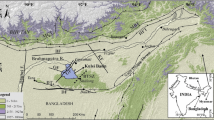Abstract
The Hexi Corridor is a Cenozoic foreland basin system at the northeast front of the Qinghai-Xizang(Tibet) Plateau. The Shiyang River, Heihe River, Beida River and Shule River, rising in the Qilian Mountains, developed two Holocene terraces each in the plain area of the Hexi Corridor. 14C ages of alluvial fills show that the lower terraces formed between 5.57 ka B.P. and 3.15 ka B.P., the higher terraces formed between 12 ka B.P. and 8 ka B.P., and there was downcutting period from 8 ka B.P. to 6 ka B.P.. Comparing the alluvial terraces with the Holocene climatic changes, it is concluded that the downcutting period was coincident with the stable warmer and wetter climate, and the aggradation took place when the climate was changing either from drier to wetter or from wetter to drier. It is the climatic changes that caused the variations of vegetation density, soil erosion, and river sediment yields which controlled the aggradation and degradations of the rivers.
Similar content being viewed by others
References
Brakenridge G. R., 1980, Widespread episodes of stream erosion during the Holocene and their climatic cause. Nature, 283: 655–656.
Chatters J. C., Hoover, K. A., 1986. Changing Late Holocene flooding frequencies on the Columbia River, Washington. Quaternary Research, 26: 309–320.
Chatters J. C., Hoover, K. A., 1992. Response of the Columbia Rivers Fluvial system to Holocene climatic change. Quaternary Research, 37: 42–59.
Cao Xingshan, 1989. The Holocene deposits in the Hexi Corridor. Gansu Geology, 10(1): 1–9. (in Chinese)
COHPAP Members, 1988. Climatic changes of the last 18 000 years: observations and simulations. Science, 24: 1043–1052.
Dethier D. P., Harrington C. D., Aldich M. J., 1988. Late Cenozoic rates of erosion in the western Espundia basin, New Mexico: Evidence from geologic dating of erosion surfaces. Geological Society of America Bulletin, 100: 928–937.
Martin C. W., 1992. Late Holocene alluvial chronology and climate change in the Central Great Plain. Quaternary Research, 37: 315–322.
May D. W., 1989. Holocene alluvial fills in the South Loup River valley, Nebraska. Quaternary Research, 32: 117–120.
Shi Yafeng, 1990. Trend and future of the climatic change indicated by shrinking of the mountain glacial lakes in middle Asia. Acta Geographica Sinica, 45: 1–13. (in Chinese)
Shi Yafeng, Kong Zhaochen, Wang Sumin et al., 1992. The property of the Holocene Megathermal climate and environment in China. In: Megathermal Climate and environment in China. Beijing: Science Press, 1–18. (in Chinese)
Wang Sumin, 1990. Environment change and Palaeoclimate of Daihai Lake since the Last Glacial. Chinese Quaternary Research, (3) 223–232. (in Chinese)
Author information
Authors and Affiliations
Additional information
This study has been supported by the National Natural Science Foundation of China. We thank the editors and reviewers for their thorough reviews of the manuscript.
Rights and permissions
About this article
Cite this article
Li, Y., Yang, J. Response of river terraces to holocene climatic changes in Hexi Corridor, Gansu, China. Chin. Geograph.Sc. 8, 53–57 (1998). https://doi.org/10.1007/s11769-997-0082-1
Received:
Issue Date:
DOI: https://doi.org/10.1007/s11769-997-0082-1




